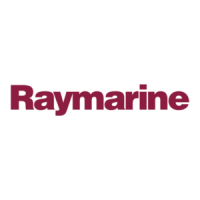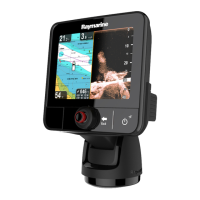
Do you have a question about the Raymarine E70012 - c97 MFD and is the answer not in the manual?
| Display Size | 9 inches |
|---|---|
| Display Resolution | 800 x 480 pixels |
| Chartplotter | Yes |
| Sonar Support | Yes |
| Waterproof Rating | IPX6 |
| Cartography | Raymarine LightHouse charts |
| Touchscreen | Yes |
| Radar Compatibility | Yes |
| Networking | NMEA 2000 |
| GPS Receiver | Built-in |
Covers general warnings, TFT displays, water ingress, disclaimers, EMC, RF exposure, FCC, and Industry Canada compliance.
Details compatible memory and chart cards, including capacity limits and usage recommendations.
Provides guidance for minimizing electromagnetic interference and adhering to RF exposure limits.
Outlines compliance statements for FCC Part 15 and Industry Canada regulations.
Lists third-party software licenses and guidance on suppression ferrites and external connections.
Covers product disposal according to WEEE directive, pixel defect policy, and warranty registration.
Specifies intended use for leisure and workboats, and notes on technical accuracy.
Introduces the handbook, its scope, and lists applicable Raymarine handbooks and part numbers.
Explains illustrations used in the manual and defines conventions for icons, menus, and controls.
Details how to identify and perform operations using touch or physical buttons on different display models.
Details system integration with marine electronics and provides an installation checklist.
Defines system component limits and networking restrictions for Raymarine displays.
Illustrates typical system configurations and explains system protocols like SeaTalkhs, SeaTalkng, NMEA 2000.
Explains the role of the data master and lists parts supplied with New a Series displays.
Lists the essential tools needed for installing the Raymarine display unit.
Provides essential guidance on cable types, routing, strain relief, circuit isolation, and shielding.
Details available connections for various Raymarine displays in a comprehensive table.
Explains power connection procedures, grounding, and power cable specifications for the New a Series.
Details power connection, grounding, and cable specifications for New c/e Series displays.
Covers network connections using SeaTalkhs/RayNet switches and cables for digital devices.
Explains how to connect GPS, AIS units, and fastheading sensors using various protocols.
Details connections for SeaTalkng, SeaTalk, NMEA 0183, and NMEA 2000 devices.
Covers connections for cameras, video devices, media players, Bluetooth, and Wi-Fi devices.
Guides on choosing optimal display location considering ventilation, interference, power, and GPS performance.
Provides instructions for surface and bracket mounting of New a Series displays, including product dimensions.
Details mounting steps for New c/e Series displays, including viewing angles and product dimensions.
Explains how to power the display on/off, use standby mode, and details controls for New a Series displays.
Describes Hybridtouch, Touchscreen, and Homescreen layouts for different display series.
Covers system checks for GPS and Radar, and enabling autopilot and AIS functions.
Explains how to manage pages, use applications, and navigate splitscreen views.
Details screen overview, pop-up menus, dialogs, and touchscreen operations for data display.
Guides through initial setup wizard, brightness adjustments, and touchscreen alignment.
Covers data master designation, GPS selection, and simulator mode configuration.
Explains memory card usage for archiving data like waypoints, routes, and tracks.
Details procedures for saving, retrieving, and erasing waypoints, routes, tracks, and settings.
Covers taking screenshots, viewing saved images, and resetting system settings and data.
Describes the PDF viewer, opening manuals and documents from SD cards, and browsing.
Explains how to activate, silence, and cancel the Man Overboard alarm.
Details how alarms are raised, displayed, silenced, and configured through the Alarms menu.
Describes connecting a DSC VHF radio for distress messages and GPS position data.
Provides steps to enable DSC Alerts within the System Settings menu.
Explains the fuel manager function, enabling it, setting capacity, and logging fuel fills.
Introduces the AIS feature, its benefits, and how it works by broadcasting real-time information.
Details required AIS hardware and how to access the AIS context menu for target information.
Explains how to enable AIS overlay in chart and radar applications and display target vectors.
Describes AIS status symbols, how to enable/disable silent mode, and AIS target symbols.
Covers displaying detailed AIS target data and using AIS to avoid collisions with safe zones and safety messages.
Details AIS options like vector length, display settings, and buddy tracking functionality.
Explains waypoint display, context menu usage, and methods for placing waypoints.
Covers organizing waypoints into groups, renaming, and erasing groups.
Details route building from scratch, tracks, lists, and navigation features like Stop Goto and XTE.
Explains how to create, set intervals for, and edit tracks.
Specifies the storage capacity for waypoints, routes, and tracks on the display.
Introduces the chart application, its uses, chart datum, and compatibility with Navionics chart cards.
Explains how to range, pan the chart, and set vessel position and orientation modes.
Covers switching between 2D/3D views, manipulating 3D charts, and using the chart context menu.
Details My Data options for managing information, navigation options, and measuring distances/bearings.
Explains chart vectors, current information display, and tide information with animated graphics.
Covers displaying chart object details, searching for objects, pilot book info, and chart presentation options.
Introduces radar, its features across different scanner types, and selecting radar scan speed.
Explains radar scanner status symbols and how to power the scanner on/off.
Discusses factors affecting radar image quality, blind sectors, clutter, and the radar display layout.
Covers dual range radar operation, compatibility, and selecting radar orientation modes.
Details on-screen gain controls, radar adjustments for HD/SuperHD and non-HD scanners.
Explains radar presentation menu options including dual range, orientation, enhance echoes, and data overlays.
Covers using radar to measure distances, ranges, bearings, and tracking targets with MARPA/Guard Zone.
Details scanner set-up menu options for timed transmit, tune adjust, sea clutter, and advanced settings.
Provides instructions on how to reset radar settings to their factory defaults.
Explains how fishfinders work, lists Raymarine sonar modules, and covers traditional vs CHIRP sonar.
Details transducer bandwidth, interpreting sonar images, and factors influencing the sonar display.
Covers fishfinder presets, display modes (Zoom, Bottom Lock, A-Scope), and changing preset names.
Explains dual/single frequency operation and frequency controls for non-CHIRP and CHIRP sonar modules.
Details sensitivity settings including gain, color gain, TVG, power mode, and onscreen controls.
Covers presentation options like target depth ID, depth lines, white lines, bottom fill, color palettes, and ping rate.
Explains how to determine depths and distances using VRM markers and fishfinder scrolling.
Details how to place fishfinder waypoints and configure fishfinder alarms.
Describes sounder set-up menu options including ping rate, interference rejection, and transducer calibration.
Provides instructions on how to reset the sonar unit to its factory default values.
Introduces the data application for viewing system and instrument data, and selecting datapages.
Lists default datapages and the data items displayed for various Raymarine display models.
Guides on customizing datapages, changing order, content, renaming, adding, deleting, and resetting.
Introduces the thermal camera application, its image display, and overview of controls.
Details camera control functions including pan, tilt, zoom, standby mode, and home position.
Covers adjusting thermal image parameters like contrast, brightness, color, and scene presets.
Explains the new camera interface, surveillance modes, and stabilization settings.
Details the power consumption for high power and high torque modes in different camera states.
Describes menu options for pan and tilt cameras using the old camera interface.
Introduces the fixed mount thermal camera application and its video image display.
Provides an overview of the controls available for fixed mount thermal cameras.
Details camera control functions and image adjustments for fixed mount cameras.
Lists the menu options available for configuring fixed mount thermal cameras.
Explains how to view camera/video feeds, cycle through feeds, and adjust video image settings.
Introduces the Fusion link application for controlling Fusion entertainment systems and media controls.
Details the layout and controls for various media sources like iPod, USB, DVD, Radio, Satellite, VHF, and AUX.
Explains how to browse music and select shuffle and repeat functions for playback.
Covers adjusting volume levels for each zone and controlling tone settings like Bass, Middle, and Treble.
Guides on selecting the Fusion system to control and lists available menu options.
Introduces the weather application, its usage in North America, and setup steps including SiriusXM subscription.
Explains the weather display features, symbols for weather conditions, and storm tracking symbols.
Covers weather map navigation, context menu options, and various weather report types.
Explains how to view animated weather graphics like radar and wind, and NOWRad overlays.
Details menu options for Find Ship, Display Graphics, Animate Weather, View Report, and Watchbox Alerts.
Provides definitions for various weather terms like Cold front, Cyclone, Hurricane, and Isobar.
Introduces the Sirius audio application for controlling Raymarine Sirius receivers and volume.
Details Raymarine mobile apps (RayView, RayRemote, RayControl) and their device compatibility.
Covers steps for enabling Wi-Fi and mobile apps on the multifunction display.
Explains how to set up Wi-Fi security (WPA2) and select a Wi-Fi channel.
Allows selection of the system language from a list of available languages.
Enables customization of vessel appearance in the chart application and setting engine details.
Allows specification of preferred units of measurement for distance, speed, depth, temperature, pressure, and volume.
Enables users to specify preferred formats for date and time display across all applications.
Covers display behavior settings like key beep, cursor autohide, range controls, and shared brightness.
Explains how to customize data displayed in on-screen cells, databar, and expanded databar.
Provides a comprehensive list of data items available for display, categorized for easy selection.
Lists available system set-up menus for configuring alarms, pilot controls, fuel manager, and audio controls.
Recommends routine equipment checks, examining cables, and referring to authorized dealers for service.
Provides best practices for cleaning the display case and screen, avoiding damage to coatings.
Provides an introduction to troubleshooting common problems with marine electronics.
Addresses problems related to power up, radar (no scanner message, incorrect bearing), and GPS (no fix).
Covers sonar issues (no data, problematic readings), thermal camera problems, and system data issues.
Addresses troubleshooting for video input, Wi-Fi, Bluetooth connectivity, and touchscreen operation.
Covers issues like erratic display behavior, resets, system crashes, and software mismatches.
Provides contact details for Raymarine customer support via website, phone, and email.
Lists contact details for third-party suppliers like Navionics and Sirius.
Details physical dimensions, weight, power specifications, and environmental specs for various display models.
Lists transducer accessories, and RayNet connector network cables with part numbers.
Details SeaTalkhs network/patch cables, video cables, and spares for specific display models.











